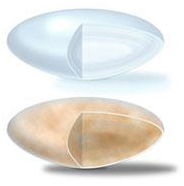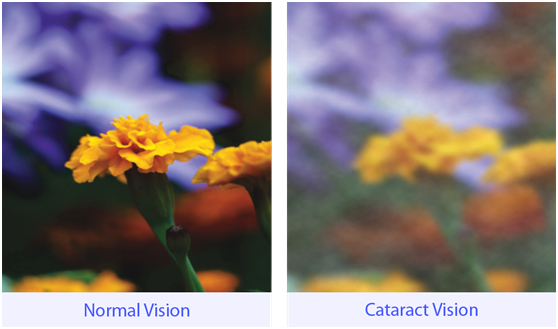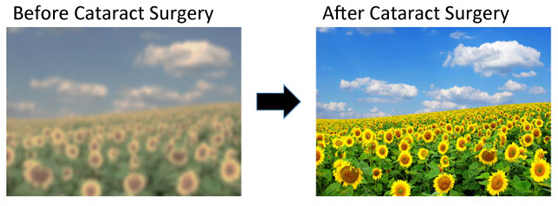QUESTIONS FREQUENTES
La cataracte est une opacification de la lentille dans l'œil. Cela affecte la vision. La plupart des cataractes sont liées à l’âge. Elles sont très fréquentes chez les personnes âgées.
Une cataracte peut toucher un ou les deux yeux. Elle ne peut pas se propager d’un œil à l’autre.
Cette lentille est le cristallin. C'est une partie transparente de l’œil qui aide à diriger la lumière ou faire la mise au point d’une image sur la rétine. La rétine est le tissu sensible à la lumière au fond de l’œil.
Dans un œil normal, la lumière passe à travers la lentille transparente et arrive sur la rétine. Une fois qu’elle atteint la rétine, la lumière est transformée en un signal dans le nerf optique qui est envoyé au cerveau.
La lentille doit être claire pour que la rétine reçoive une image nette. Si la lentille est opaque à cause de la cataracte, l’image sera floue.

Les cataractes liées à l’âge peuvent affecter votre vision de deux façons:
- - Des amas de protéines réduisent la netteté de l’image atteignant la rétine. La lentille est principalement constituée d’eau et de protéines. Quand les protéines se regroupent, cela opacifie la lentille et diminue la quantité de lumière qui atteint la rétine. Le voile peut devenir assez important et provoquer une vision floue. La plupart des cataractes liées à l’âge sont liées à ces amas de protéines. Quand la cataracte est légère, l’opacification ne touche qu’une petite partie de la lentille. Vous ne remarquez certainement aucun changement de votre vision. Les cataractent évoluent souvent doucement et la vision se dégrade progressivement. La plupart du temps, la zone opacifiée s’étend dans la lentille et l’importance de la cataracte augmente. La vision devient alors difficile. Elle est plus terne ou floue.
- - La lentille transparente change doucement de couleur pour devenir jaunâtre ou brunâtre. Cela change la couleur de la vision. Quand une lentille transparente se colore avec l’âge, votre vision prend progressivement une teinte brune. Avec le temps, cette teinte rend la lecture difficile et gêne lors des activités de la vie quotidienne. Si vous avez une coloration de la lentille avancée, vous ne serez plus capable de distinguer le bleu et le violet.

Le risque de cataracte augmente en vieillissant. Les autres facteurs de risque sont:
- - Certaines maladies (le diabète par exemple)
- - Comportements personnels (tabac, alcool)
- - L’environnement (exposition prolongée aux rayons ultraviolets de la lumière du soleil)
Les symptômes les plus fréquents de la cataracte sont:
- Vision floue ou voilée.
- Les couleurs semblent plus fades.
- Eblouissements. Les phares, les lampes ou la lumière du soleil apparaissent plus brillants. Un halo peut apparaitre autour des lumières.
- Vision de nuit difficile.
- Vision double ou multiples images dans un œil. (Ce symptôme peut disparaitre à mesure que la cataracte grossit.)
- Changements fréquents de la correction de vos lunettes ou lentilles de contact.
Ces symptômes peuvent aussi être le signe d’autres problèmes. Si vous avez certains d’entre eux, consultez votre médecin ophtalmologue.
Oui. Bien que la plupart des cataractes soient liées au vieillissement, il y a d’autres types de cataracte.
- Cataracte Secondaire: Des cataractes peuvent se former après l’opération à cause d’autres problèmes oculaires comme le glaucome par exemple. Elles peuvent aussi se développer chez des personnes ayant des problèmes de santé comme le diabète. Elles sont parfois aussi liées à l’utilisation de stéroïdes.
- Cataractes traumatiques: Des cataractes peuvent se développer après un choc à l’œil, parfois des années après.
- Cataractes congénitales: Certains bébés naissent avec des cataractes ou les développent durant leur enfance. Ces cataractes sont souvent trop petites pour affecter la vision. Mais si cela était le cas, la lentille doit être retirée.
- Cataractes de rayonnement: Des cataractes peuvent se développer après une exposition à différents types de radiation.
Une cataracte est détectée grâce à un examen oculaire complet comprenant:
- L’acuité visuelle. Ce test permet de savoir ce que vous voyez à différentes distances.
- - Examen de l’œil dilaté : Des gouttes sont mises dans les yeux pour ouvrir, ou dilater, les pupilles. Votre ophtalmologue utilise des lentilles grossissantes spéciales pour examiner votre rétine et votre nerf optique afin de détecter des dommages et d’autres problèmes oculaires. Après l’examen, votre vision rapprochée sera floue pendant plusieures heures
- - La tonométrie : un instrument mesure la pression dans votre œil. Des gouttes anesthésiantes peuvent être appliquées pour ce test.
Votre ophtalmologue peut aussi faire d’autres tests afin de mieux connaître la structure et l’état de santé de vos yeux.

DEFINITION
La chirurgie consiste à enlever la lentille opaque et à la remplacer par une lentille artificielle.
TRAITEMENT
La chirurgie consiste à remplacer la lentille opacifiée par une lentille artificielle.
Une fois que vous avez compris les bénéfices et les risques d’une chirurgie, vous pouvez décider si vous êtes d’accord avec une opération de cataracte.
Parfois, une cataracte doit être enlevée même si elle ne pose pas de problème de vision. Par exemple, une cataracte doit être opérée si elle empêche un examen ou le traitement d’un autre problème oculaire, comme une dégénérescence maculaire liée à l’âge ou une rétinopathie diabétique.
Si vous avez une cataracte dans les deux yeux, les chirurgies ne seront pas faites en même temps.

Porter des lunettes de soleil et un chapeau pour bloquer les rayons ultraviolets du soleil aide à retarder la cataracte. Arrêter de fumer. Les chercheurs pensent qu’une bonne alimentation peut aider à réduire le risque d’une cataracte liée à l’âge. Ils recommandent de manger des légumes verts, des fruits, et autre nourriture contenant des antioxydants.
Si vous avez 60 ans ou plus, vous devriez passer un examen oculaire dilaté complet au moins une fois par année. En plus de la cataracte, votre ophtalmologue doit contrôler les signes de dégénérescence maculaire liée à l’âge, de glaucome, et d'autres problèmes de vision. Le traitement précoce de nombreuses maladies oculaires peut sauver votre vue.

OPERATION DE LA CATARACTE
La chirurgie consiste à enlever la lentille opaque et à la remplacer par une lentille artificielle.
